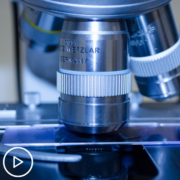Myeloma Targeted Therapy: Why Identifying Chromosomal Abnormalities is Key
Myeloma Targeted Therapy: Why Identifying Chromosomal Abnormalities is Key from Patient Empowerment Network on Vimeo.
Charise Gleason, a nurse practitioner, provides insight as to why identifying chromosomal abnormalities is essential when it comes to targeted therapy as a treatment choice for myeloma.
Charise Gleason is a nurse practitioner specializing in myeloma and serves as the Advanced Practice Provider Chief at Winship Cancer Institute of Emory University. Learn more about Charise, here.
Related Programs:

|

|

Key Considerations When Choosing Myeloma Treatment: What’s Available? |
Transcript:
Charise:
So, testing for chromosome abnormalities or changes are important when it comes to targeted therapy.
And we used to think of this more in that relapse setting. But we also look at it upfront now, because it tells us more about the path of myeloma. And there are reasons to check throughout at relapse, again, to see if something’s changed. So, with targeted therapy, we can use the translocation (11;14), for instance.
Many patients have a translocation t(11;14). It’s not a high-risk feature. But we know on clinical trial we have a drug that we’re using called venetoclax that those patients can be very sensitive to.
And so, we’re looking at this not just in translocations but in sequencing for other abnormalities or gene mutations that can help guide us with these newer therapies. And you see that across all cancer types at this point. So, you can get very specific with a patient’s type of myeloma – that this drug is going to work better because you have this mutation.
So, we look at it upfront. It guides us for risk stratification: standard risk versus high risk. And then we look at it in that relapse setting. Do we have a drug or a clinical trial that this patient will respond better to because of those abnormalities?
When we’re risk stratifying, we know standard risk, medium risk, and high risk. Those are those translocations, those gene mutations, that we know about.
But newer testing, like sequencing, gives us a lot more mutations that we don’t even know what to do with them all yet.
We don’t necessarily have drugs for all of them, but it does help guide us down the road. So, right now some common are the translocations, but also deletion 17p, which we’ve known about for a while. But maybe you see a BRAF mutation, which you typically associate with other types of cancers, but we see that in myeloma as well.
So, it helps us look at is there a drug that our myeloma patient might benefit from because they have a BRAF mutation, for instance.




